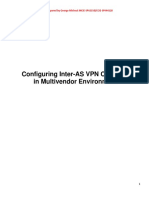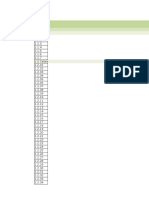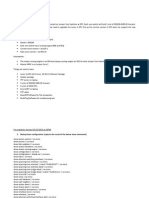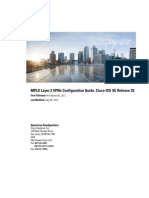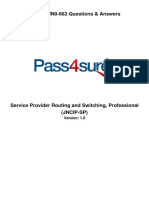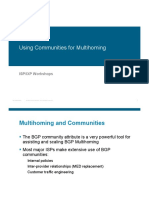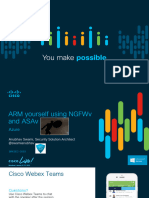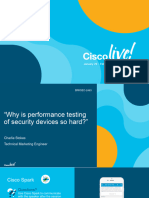0 ratings0% found this document useful (0 votes)
408 views30 pagesCCIE SP v5 Lab Deploy Demo
Uploaded by
neo.sanjeev6666Copyright
© © All Rights Reserved
We take content rights seriously. If you suspect this is your content, claim it here.
Available Formats
Download as PDF or read online on Scribd
0 ratings0% found this document useful (0 votes)
408 views30 pagesCCIE SP v5 Lab Deploy Demo
Uploaded by
neo.sanjeev6666Copyright
© © All Rights Reserved
We take content rights seriously. If you suspect this is your content, claim it here.
Available Formats
Download as PDF or read online on Scribd
You are on page 1/ 30
CCIE Deploy Guideline:
1. Section 1: Core routing (25%!
4st. Section 1.4, 15-15 (4
Solution
Verification
1.2. Section 1,2: BGI
Solution .....
Verification
1.3. Section 1.3: Segment Routing — SR (3 points)
Solution ....
Verification
Section 1.4: SR Mapping Server (2 points).
Verification.
1,5. Section 1.5: SR-TE (4 points),
Solution ......
Verification
1,6. Section 1.6: PCE and PCEP @ points),
SOMUION sso.
Verification ‘
1.7. Section 1.7: RSVP-TE (2 points:
Solution «........
Verification
1.8. Section 1.8:
2. Section
ehitectures and Service (25%)
Section 2.1: EVPN-VPWS (3 points)
+ L3VPN Intra-AS (4 points)..
2.3. Section 2,3: Mapping SDA VNs to SD-WAN VPNs (4 points)
Solution ....
Verification
2.4. Section 2,4: Multicast VPN (3 points).
Solution
Verification
2.5.
Solution
Verificati .
2.6. Section 2.6 Operate EVPN (1 points)
3, Section 3: Access Connectivity (10%) «
3.1. Section 3.1: Loop prevention Techniques in Multihomed
Environment (2 points’
Solutio
Verification.
4. Section 4: High Availability and Fast convergence (10%) se
4.1, Section 4.1 IS-IS Priority path convergence (2 points;
Solutio
Verification.
4.2, Section 4.2. BFD (2 points:
4,31 Section 4,3 NSR (1 point)
5, Section 5: Security (10%) ..
5,1, Section 5,1: SSH | Management Plane Security (4 points) ,
Solution...
Verification...
5.2. Section 5.2 BGP Flawspec (2 points) 47
Solutio +147
Verification ...
5.3. Section 5.3, BGP Security (2 points)
6, Section 6: Assurance and Automation (20%)
6.1. Section 6.1: SR and MPLS OAM (1 point).
Solution.....,
Verification,
6.2. Section 6.2 NSO (4 points)
Solution
Verification,
Solution,
Verification.
6,3, Section 6,4: Netflow and IPFIX (1 point).....
CCIE Deploy Guidelines
1, CCIE Service Provided DCO Module Deploy, Operate and Optimize.
Before you starting, please read the below guidelines,
2, The network that you will deploy, operate and optimize in this module
will be similar, but not necessarily identical to the network designed
in the previous module, All relevant information that is needed to
successfully complete this module can be found in this module itself
and overrides any information that was provided in the previous
module.
3. Before you start confirm that all devices in your rack are accessible.
During the exam, if any device becomes locked or inaccessible, you
must recover it,
4, Do not change these parameters, unless you are specifically told to:
Hostname and interface descriptions
Username admin password admin
NSO Credentials = Username nsoS, password CCIEsplab
Line console static and default routes are not permitted unless
explicitly stated. This includes floating static routes and routes that
are generated by routing protocols.
vvvy
5. The following routing protocols are partially preconfigured, Additional
configuration requirements can be found within the exam itself.
Basic IGP
> External BGP
> BGP
Basic MPLS
v
v
6. Points are awarded only for working configurations. No partial scoring
is provided, It is recommended that toward the end of the exam you
go back and test the functionally as per all question requirements,
7, If you need clarification on any of the questions, or if you suspect that
there might be a hardware issue with your equipment, Contact the
lab proctor as soon as possible.
8, Item level feedback can be provided at the question level, Feedback
will be processed, but Cisco will not reach out to you to discuss any
feedback provided. You will not be compensated for time you spend
providing feedback,
9, Access to select Cisco online documentation is available from your
desktop,
10,When you finish the lab exam make sure that all devices are
accessible for the grading proctor, by having them in EXEC mode and
close the console windows. A device that is not accessible for reading
cannot be marked, and this may cause you to lose substantial points.
For Cisco 10S XR devices, make sure that you commit all of your
changes and have the prompt in the EXEC mode. Failure to do this,
can delay your lab grading,
11, You have 5 hours to complete this module, Upon finishing the exam,
ensure that all devices are accessible. Any device is not accessible for
grading purpose may cause you to lose substantial points.
5
2
>
L
>
3
=
The Emerald Tier 1 service pravider operates in different geographical locations,
Enable IS-IS in this network across three instances (AGG1, CORE and AGG2),
given these requirements
= Make sure all three IS-IS instances are in layer 2.
+ Derive the NET-ID where the last three octets of the device loopbackO
address should match the system 1D of the node, For example, loopbackO
address af —-10,255,0,1._— should «shave =o net’ «Ss ID—oof
49,0001,0010,0255.0000,0001.00.
* Only use flexible CLI configuration groups called CCIE-ISIS to simply the
configuration, Use AGG1, CORE and AGG2 IS-IS instances for both 1PV4 and
IPV6 respectively.
+ Use the same 1S-IS database for IPV4 and IPV6.
= Make sure to allow IS-IS to be able to use metric values higher than 63, Use
a Layer 2 metric of 200 for IPV4 and 400 for IPV6,
+ Make sure IS-IS adjacency formation/maintenance is optimized from the
bandwidth utilization point of view using flexible, CLI configuration groups,
+ Make sure not to leak IGP routes between the three IS-IS instances.
* Interfaces connected between nodes need to be P2P,
* Make sure both route reflectors (RR) are reachable from the IS-IS CORE
instance.
+ Make sure LDP is enabled in each IS-IS instance.
Refer to Diagrams and Tables 1,2,3 and 4 for more details,
Solution
With requirement: Make sure LDP is enabled in each IS-IS instance we
should remove the global on preconfigure and configure mpls auto-configure
under the IS-IS process,
PES, X-PEG, X-P1, X-P2, X-P3, X-P4, X-ASBR1, X-ASBR2:
o mele ap
mpis lp
* Configure group CCIE-ISIS for those devices.
ccleaCareer.com
Tectype level=2-anly
amily ipva unicast
addres
netric-style wide level 2
mpls ldp auto-cenfig
address-family ‘pv6 unicast
tyle wide level 2
single-topology.
terface ‘Loop
address-family Lpvé un
address-family ip
cast
interface 'Gigabit@ehernat
point-to-point
hellc-padding disable
address-Camily ipvd unicast
metric 200 level 2
address-family ipv6 unicast
metric 400 level 2
X-PL
gouler isis AGGI
apply-gzoup CCIE-1S1S
net 49.0001 .0001.0000,0100. 0003.00
nterface Loopback0
nterface Gigabitetherner0/0/0/2
router lais CORE
apply-group CCIE:
net 49.00
Loonbacko
Gigabitethe:
interface Gigabitetherneto/0/0/1
interface GigabitBthernet0/0/6/3
interface Gigabitethernet0/0//4
x-P2
outer isis AGGE
apply-gzoup CCIE-Is1s
net 49.0001 .0001.0000.0100.0004.00
interface Loopback
nterface GigabitEthernet0/0/0/2
router isis CORE
spply-geoup CCTE-TS1s
net 49.0001 .0001 .0000 .0100.0004.00
nterface Loopback?
interface
antertace
interface
nterface
TOUEGE isis &
Ly-gzoup
49.9001 .0001.0000.0100.0005.00
nterface l
pbacko
nterface Gigab
hernet
1o/o/:
router sig CORE
apply-group CCIE-tsts
net 49.0001.0001.0000.0100.a005
0
interface Loopback?
interface Gi
hernetd/0/0/9
interface Gigabil
forest
=theri
CCIE4Career.com
Wtertase Gigabitethemeto/0/074
comm
x-P4
apely-group CCIE
net 49,9001.9001,0000.0100, 0086.00
nterface Loopback
nterface Gigabitethernet0/0/0/1
apply-gzoup
net 49.
000,010, 0006.09
nterface
terface
anterface
pero /O#O/2
rovosald
nterface Loopback0
CCIEACareer.com
nterface Gigabitet
Ethex
nterface Gigal
X-ASBR1
up CCIE-IsIs
9002,0001,0000,0100
oopback®
Lnlerface
intere:
X-ASBR2
Touter isis AGGe
soup CCH
01.0002.
apply
49.00
Laterface Lespbad
nterface GigabitEthe
pvé vouter isis
no isis hello
49.0001 .0001. 00:
isctype level-Z-only
metric-style wide 11
e100 .ee09. 00
1-2
metric 400 level=z
amily
mpls ldp auteconfig level-2
X-RR2
ne isis hello
49. 00.9100.0010.00
style wide Level-2
metric 200 leve
- Verify that ISIS neighbors are “Up” and has routes for both
ipv4/ipve.
~ Loopback X-RR1, X-RR2 adver into ISIS Core.
mon Aug 7 15:14:14,914 UTC
AGGL neighbors:
ta Inter face ype
speopY up “2
Interface SNPA ate tloldtime Type TE!
rosoya Up 24 1
640/0/0/0 up w
capable
CCIEACareer.com
ea Gia 0/071 + PtoE™
capable
XeRRT Gioso/osa sPtept
Capable
Total neighbor count: 4
2 13:35.017 UTC
1.0,100.3/32 ie directly connected,
L
‘AP/O/O/CPUD:X-Piéshow 818 topology
Sun Aug 18.550 OTC
IS-IS AGEL paths to Tev4 Unicast (Level~
system td Metric Next-iieg
y-PI -
ACPES 20000 X-PES
XOERG 400 X-PES,
IS-I8 CORE paths to IPvd Unicast (Level-!
System Td Metric Next-Hop
IPL -
xoP2 200 xe
¥-P3 2000 X23
YePE 200 XPS
YoRRL 20000 XORRL
YoRRE 400 x2
Sun Aug 7 15:15:25,209 urc
Up 28
up 2
1d20h, Lospbaekd
4 22 1.0,100.4/32 [118/400] via 1.100.7.2, 01:00
GigabitEthernet0/0/0/i
i £2 1.0.100.5/32 [115/400] via 1.100.3.3, 00:04:43,
Gagabitzthernet0/0/0/2
112 1,0.100.6/32 [115/400] via 1,100.42. 4,
GigabitEtherneto/0/0/4
4 E2.1,0,100.7/32 [115/400} via 1,100:5,5, 00:52:34,
GigabicEthernet0/0/0/2
4 2 1,0.100.8/32 [125/600] +100,5.5, 00:51:30,
Gigabicuthernet0/0/0/2
i 12 1.0,100,9/32 [113/200] via t.100.11.2, 00:46:54,
Gigabitethernet0/9/0/3
4 £2 1.0.106,10/32 [115/490] wia 1.100.7/2, 00:44:24,
GagabitEtherme10/9/0/0
E 1,100,3,1/32 is directly connected, 1420h, GigabitEtherneto/9/0/1
L 1, 100.5.1/22 is directly connected, 1d20h, @igabieEthernet0/9/0/2
L -1,100.7.1/32-43 directly connected, 1¢20h, Gigabitethernet0/0/0/0
L 1,100,11,1/52 ie dixectlp connected, 1d30h, Gigabiththernet0 /0/0/3
L 1,100.42.1/32 is directay connected, 1d20n, Gigabitethernet0/0/0/4
2) routers
Interface sNen
Giasorar2. *PLoP*
610 /0/0/2 +PLopt
2) routers
Taterface SNPA
Gisso/a/o “Props
Gsos0/0/1 "prep
Gi0/o/o/4 *Ptop*
G10/0/0/3 +PLoRe
si0s0/0/0 *ptorr
TS-15 AGGI paths to IPve Unicast (level-2) rouver®
system Id Matric Nex! Interface NPR
200 cio/o/o/e *Ptoe*
409 Gi0/0/0/2 “Pope
600 Gao/o/o/e *PtoR*
IS-18 CORE paths to 1Pv6 Unicast (level-2) routers
System I Matric Mext-Hop Interface NBA
200 cin/o/o/0 * Pope
200 Gio/o/a/L *PtoR*
200 Gi0/o/o/a + Prope
YORRL 200 Gi0/0/0/3 *Ptoe*
YORE 400 10/0/0/0 ¥EtoRt
X-RRL
Load for five secs: W4/
Time source is hardware calendar,
ve minutes: 0%
UIC Sun Aug 7 2022
system
wP1
tettace IP Address State Holdtime Cireuit Id
gto/1 1.100.2141 UR 28 00
+0,L00,a/92 [115/400] wie 00:49:17, Ethernet0/i
L2 1,0,100.4/32 [115/600] via 00:49:17, Btherneta/1
222 1,0,100,5/32 [125/000] wa 1,100,111, 00:07:06, Ethernet0/1
1.0.100.6/32 (115/600) vie 1,206.11,1, 00:49:17, Btherneto/1
1.0,100.9/32 Le directly conneted, Loopback
1.0,100.10/32 [115/600} vis 1.100.11.1, 00:46:47, Btherneto/1
L 1,100,11,2/32 is directly connected, Eth
st
1.2. Section 1,2: BGP=Unified MPLS (3 points)
Implement Unified MPLS across the core and aggregation metro fabric at the
Emerald Tier 1 SP as per given requirements:
+ All the X-PE and X-ASBR devices loopback should be learned in different
IS-IS domain and not via IGP
+ All the X-PE’s and X-ASBR devices |oopback0 should be reachable via MPLS
path,
* Create IBGP-LU in core IS-IS process using X-RR1 and provide redundancy
on X-RR2,
* Use suitable inline Route reflectors for AGG1 and AGG2 processes
Refer to Diagrams and Tables 1,2,3 and 4 for more details,
Solution
X-PES
youter bap
X-PE6
Fouter bap 10
fanily ipvd unieast
network 1.0.100.8/32
allocate-label all
CCIEACareer.com
Tabeled=anioast
addresa-family
nexcnop=self
neighbor 1.0.100.3
use neighbor-group
gt
lise neighbor
Touter Sap
poliey out enforce-nodi fications
v4 unicast
100.3/32
bay
idress—LamL
next-hop-selE
cast
s-family ipw4 Labeled=un
Le
1.0,100.7
roup
nekghier
use neighbor-g
1.9,100.8
ighbor
CIEACarear com.
router bap 100
ibgp policy out e
aciirese—family ipv4 unicast
network 1.0.100.4/32
ate-label all
torco-nodifications
neighbor-group RR_CLIENT
gemote-as 10
update-source Loopback?
addvees-family ipva labeled—unicast
nex=—nop-sele
ghbor 1.0,100.1
use neigh. oup RR_CLIENT
neighbor 1.0.10
use neighko
Sap RR_CLIENT
ghbor 1.0.100.9
use neighbor-group TO_RR
neighbor 1.0,100,10
use neighbor-gro\
router bgp 100
ibgp policy out
addvess—fanily ipvd unicast
network 1.0.100.5/32
allocate-ta
@ Leepbackd
atidress-family ipv4 lakeled~anicas:
nexs-hop-self
CCIEACareer.com
Teighborsgroup AR CLIENT
romote~as 100
wpa,
address-family ipv4 labeled-anieast
nexs“hop-sel f
ource Leepbackd
ighbor 1,0,100,7
use neighbor-group RR_CLIENT
ghbor 1.0.100.8
use neighbor-group RR_CLIENT
neighber 1.0.100.9
use neighbor-group 70 RR
nekghbor 1+0+100-19
use neighbor-sroup TO_RR
X-P4
Touter bgp 100
ibgp policy out
address~fam:ly ipv4 unicast
network 1.0.100.6/32
allocate-label all
Fores-modi fications
neighbor-group T0_RR
remore-as 160
update-souree Leopba:
address-family ipva labeled
next-hop-sel f
neighbo:
updacs
address-famlly Leva
xtchop-self
~saurce Loophack0
neighbor 1.0.100.1
use neighbo:
neighbor 1.0.100.2
use neighbor-group RR_CLIENT
ghbor 1.0.100.10
use neighbor-croup TO_R!
X-ASBR1
Touter Bap 10a
address—fani ly ipv
\eighbor 1
use neighbor-group
neighbo:
use neighbor
X-ASBR2
outer Bap 100
wa unicast
sctamily ip
network 100.2/32
allocate-label all
neigh 1p TO_RR
am a
update-saurce LeopbackO
address-fanily ipv4 labeled-unicast
neighbor 1.0,100.4
use neighb:
neighbor 1.
uae neighbe:
X-RR1
router bgp 100
p router-dd 1.0.100.9
o bgp default ipvi-unieast
RR_CLIENT ‘cup
= RR CLIENT rencte-as 100
RR_CLIENT update-sevree loopback 0
1.0.100.3 peer-group RR_CLIENT
10-100.
1.0.100.5
1.0-100.6 pee.
unicast
eighbor RR_CI route-reflecter-elient
neighbor RR_CLIENT send=1a
neighbor 1.0,100.3 activate
1.0.100 ivate
hor 10,100
ghbor 1,0.100
X-RR2
router bgp 100
er-id 1.0.100.16
ne Bop default ipvé-unicast
neighbor RR CLIENT peer—gzoup
neighbor RR_CLIFNT renete-as 160
eighbor RR_CLIENT update-salrca loopback
ghbor 1.0.109.3 peer—group 28 c:
wighbor 1.0-100.4 peer—group
ghbor 1.0-100.5 peer-group
bgp
neighbor 1.0.100.6 peersgroup F
ghhor RR_CLIENT route-refl
eighbor RR_CLIENT send-label
bor 1.041003
eighbor 1.0-100.
neighbor 1.0.100.5
ghbor 1,0.100.6
Verification
‘+ X-PES and X-PE6 can traceroute to X-ASBR1 Loopback or X-ASBR2
Loopback.
CCIEACareer.com
Thu Sep 22 16:42:37,584 UTC
BGE routing table entry for 1.0.100.1/32
Versions:
Frocess DRIB/RIB SendTblVer
Speaker 23 23
Lecal Label: 24006
Last Modified: Sep 22 16:42:37,946 for 236y10w
Paths: (2 available, best #1)
Not advertised te any peer
Path #1: Received by speaker 0
Nat advertised te any peer
Tacal
1,0,100.3 (metric 200) from 1,0.100.3 (1+0,100.1)
Received Label
Origin IGP, metric 0, localpret 100, valid, internal, best, group~
Best; Laboled-unteant
Received Path 1D 0, Local Path I 1, version 21
Originator: 1.0.00. 1.0.200.3, 1.0.100.5, 1.0.100.4
Path 2: Received by apeater 0
Not advertised 2 any
Local
1.0.100.5. jet
Received sabe! 2A
Origin 16P, metric G, localpref 100, valid, internal, labeled-unicast
Recaived Path ID 0, Local Fath 10 G, version 0
Originatoxs'1.9.100.1, Cluster list: 1.0/100.5, 1.0.100.9, 1.0.160.4
from 1.0.100,8042.9.190.2)
Thu Sep 22 16:49:24,347 UTC
Type escape sequence td abe
Tracing the route to 140,100+L
1 1,100.5.1 [MPIS: Label 24013 Bxp 0] 19 mse
2 1,100.7.2 [MPLS: Lebel 24009 Exp 0] 23 mse
3 1,200.12 9 msec * 9 msec
Thu Sep 22 16:49:31,516 0Tc
9 msec 9 msec
19 msec 19 meee
Typs escape sequence to abort.
Tracing the route to 1.0.100.2
1.100.5.1 [MPLS: Label 24014 Exp 0] 69 msec 19 msec 29 mage
1,200.7.2 MPLS: Label 24010 Exp 0] 19 msec 19 meee 9 meee
1,100.1.1 [MPLS! Label 24002 Exp 0] 29 msec 19 msec 9 msec
1.200.21.2 19 meee * 19 meee
CCIEACareer.com
1.3. Section 1.3: Segment Routing — SR (3 points)
‘At the kyanite Tier 2 service provider, implement segment routing on all nodes,
given these requirements.
+ IS-IS Layer 2 is already enabled on all Z nodes. (P, PE, and SR-PCE).
+ Any configuration done to meet this question’s requirement is to be added
under the respective IS-IS instance and not under the flexible CLI
configuration group used as a base template,
+ Enable segment routing on the Kyanite Z — P, PE and SR-PCE devices for
both IPV4 and IPV6 using these guidelines:
© Use the last octet of loopback0 IPV4 address as the prefix-sid index
for IPv4. For example, Z-P1 loopback0 last octet is 1 so IPv4 prefix-
sid should be 1
For TPv6 use 1000 plus the last octet of loopback0 IPv4 address as
the prefix SID. For example, Z-P1 loopback0 last octet is 1. So, the
IPV6 prefix list should be 1001,
All nodes should use the defeult segment routing global block range.
Make sure the segment routing local block range is from 25000 to
25000 on all nodes.
+ The kyanite service provider wants Z-PE1 and Z-PE2 to operate as a
redundant group of nodes for certain services for both IPv4 and IPV6. For
this purpose, a loopback 99 has been created on each of these PE devices
and configured with the same IP address, Configure Z-PE1 and Z-PE2 to
ensure that all routers see a prefix SID associated with this loopback prefix,
however, this should be a Node-SID. Use SID index 99 for IPv4 and 1099
for IPv6.
+ Enable IGP fast Reroute within the kysnite SP without configuring any
additional control plane protocol. This FRR mechanism should be
independent of the physical topology of the network and should provide
100% coverage,
Refer to Diagrams and Tables 1,2,3 and 4 for more detaiis.
2-P1, Z-P2, Z-PE1, 2-PE2, Z-PE3, Z-PE4, Z-ASBR
k 25900 26000
Z-P1
Zouter isle CORE
address-fanily
segment-routing mpls sr-prefer
pd unicast
address—family ipv6 unicast
segment-routing mpls sr—pzefer
boopback®
addzess-family ipvd unicast
prefix-sid index 1
address-family ipv6 unicast
prefix-sia index 1001
interface GigabitEth
oso/0s0
x level 2
& ti-léa level 2
address-forily
fast-rex
revel 2
interface Gigabitethe:
addres:
amily
fast-reroute per-pre
fast-reroute per-pre
v4 unicast
x level 2
x ti-lfa level 2
address-family ipv6 unicast
fagt-reroute per-prefix level 2
fast-reroute per-prefix ti=[fa level 2
GigabitBthernet0/0/0/2
addvess-family inva unicast
fast-reroute per-prefix level 2
fast-re
ute per-prefix ti-lfa lave!
address: nieast
fast-reroute per-prefix level 2
fast-reroute per-prefix ti-lfa level 2
nterface GigabitEthernet0/0/0/4
address-family ipy4 uni:
fast-reroute per-prefix level 2
fast-reroute per-prefix ti-lta leve
addvess-family ipv6 unieast
fast-reroute per-prefix level 2
Z-P2
outer isis CORE
addre
segm
address-fanily ipwé
outing mpl,
ace Gigabitether
address— ipwa
fast-rercute per-
fast-reroute per p
fast-rereute per-p
fast-rerouts per-ps 2
k gabitethe
‘amily ipv4
tereroute per-prefix level 2
e per-prefix ticlfa level 2
anily ipvé unicast
fast-reroute per-prefix level 2
fast-reroute per-prefix ti-lfa level 2
Gigabitetherneta/0/0/2
anily ipvd unicast
@ per-prefix level 2
efix Li-lfa level 2
address
fast-rerou
fast-re
oute per-
address-Sami
y ipvé
fast-rereute per-prefix level 2
fast-r @ per-prefix ti-lfa
GigabitRthe
family ipv4 ui
toreroute per-prefix
fast-reroute per-prefix
address-fanily invé unde.
© per-prefix level 2
te per-prefix 4
fast-rere
fast-rerov
address:
segment»
face Loopbacka
ss-fanily ig
xcsid index 3
ce Leophack99
family ipva
wsid index 99 n=
address-family ipvé unicast
prefixsid index 1099 n-flag clear
interface Gigabitethernet0/9/0/0
address-fanily ipw4
ute perp
fanily ipvé unicast
per-p
per-prefix ti 2
rface GigabitEthe:
address-Zanily ipv4 up
fast-rero
fast-rerou
tO /0/0/1
east
© per-prefix level 2
© per-prefix ti
Ifa level 2
aaaEeas-
anily ipvé unicast
fast-reroute per-prefix
fas
level
oute per-prefix ti-1fa leve
nterface GigabitBthernet0/0/0/2
address-fami
y ipv4 unicast
fast-reroute per
fix level 2
fast-reroute per-prefix ti-lfa level 2
addres
ily ipvé unieee
fast-reroute per-prefix
level 2
jute per-prefix t:
a
address-famil
ipva uns
segment-rout i
9 mp.
face Loopback®
xcsid index 4
pref!
address-family
pre
ipv6 unicast
xegid index lo04
interface Loophack99
addzess-
amily tpvd undeast
x-sid index 99
s-family ipvé unicast
prefix-sid index 1099 n-flag-clear
erface GigabitEthernet0/0/0/0
addzess—fanily lovd undeast
fasta
¢ per-prefix lev
fast-reroute per-prefix ti-lfa
2
address-family i
fast-reroute perprefix level 2
Fast-revoute per-prefix ticlfa 2
interface
gabitEthernet0/0/0/1
address-fanily ipa unicast
fast-reroute per-prefix level 2
fast-reroute per-prefix ti-lfa leve
dress-fanily invs
fast-reroute per-prefix level 2
fast-reroute per-prefix t
fa level 2
nterface Gigabitstherner0/0/0/2
address-fanily ipv4 ur
t-reroute per-prefix level 2
icreroute per-prefix ti-lfa level 2
cast
address-fanily ipvé unic
East-reroute per-prefix level 2
fast-reroute per-prefix ti-lfa level 2
addres.
segme
amily ipvé unicast
routing mp1s sr-prefer
interface Lospback0
address-fanily ipw4 unicast
index 5
address-fanily ipvé unicast
prefix-sid index 1005
interface
gabitEthernet0/0/0/0
address-fanily ipvd unicast
fast-reroute per-prefix level 2
fast-reroute per-prafix ti-lfa level 2
address-fanily ipw6 unieas
fast-reroute per-prefix level 2
fast-reroute per-prefix ti-lfa level 2
interface GigabitEthernet0/0/0/1
address-family ipvd unicast
fastcreroute per-prefix level 2
fast-reroute per-prefix tinlfa level
Tantly ipvé unieast
fastereroute per=prefix le
fas
reroute pe:
prefix &
ily ipva
routing mpl
amily ipvé unicast
d index 6
family ipvé unicast
refixcsid index 1006
avavayo
level 2
fa level 2
cute per-pre
Z-ASBR
Fouter isis COR!
ily
seqment-reuting m
address-fai
address-tanily Ipve unicast
segnenterouting mpls sr=prefer
back
ly pwd unicast
ips waleaee
dex 1010
GigabitEtherneto/9/0/0
mily ipvd unicast
fast-reroute per
prefix level 2
fast-reroute per-prefix
fas
feroute per-pr
interface Gigabitevh
address-family ipyé unicast
fast-reroute per-prefix level 2
fast-reroule per=prefix ti-Ifa
exnet9/o/o/2
addres!
fas
mily ipve
cast
reroute per-prefix
reroute pex~pret
routing
local-bleck 25000 26000
Verification
Z-PE3
Sun Aug 14 16:58:24,667 UTC
nacast FRR summary
High
Priority
0
Some paths protected 9 a
Unprotected a a
Protection coverage 008 0.008
Total
18
°
°
10.90%
The Sep 22 17:16:24,485 UTC
Codes: C = connected, $ - static, R= RIP, B= BGR, (>) = Diversion path
D = SIGRP, EX — ZIGRP external, 0 - OSPF, IA - OSPF inter area
NI = OSPF NSSA external type I, N2— OSPF NSSA external type 2
Fl - OSPF external type 1, F2 ~ OSPF external type 2, F - BOP
d= ISIS, Ll — 18-28 level-l, L2 - IS-I8 level-2
= IS-1S Inter area, su — TS-25 summary aull, * - candidate default
- percuser static route, 0 - ODR, L - local, G - DAGR, 1 - LISP
= access/subscriber, a - Application route
= mobile route, © — REL, t~ Traffic Engineering, (I) IERESEESSEEEEE
oer
Gateway of last resort is not set
2 3,0,3,1/92 (215/200) 00:00:48, GigabitEthernet0/9/0/0
(115/400) 00:00:48, Gigabicetherneto/0/0/1 (1)
i L2 3.0,3,2/32 (115/400) 00:00:48, GigabitEthernet0/0/0/0
{115/600} 00:00:48, GigabitEthernet9/0/0/1 (ty
£ 12 3.0.3.3/32 [215/400] 09:00:48, Gigamiezthernet0/0/0/0 (!}
{115/200} 0:00:48, GigabitEthernet0/0/0/1
i 12 3.0.3,4/32 (115/600) 00200141, GigabitBthernet0/0/0/0 (1)
(115/400) via 3.302€.1, 00:00:41, GigabitBthernet0/0/0/1
3,0,3.8/32 is directly connec!
i L2 3,0,3,6/32 [115/600] via 3.30
1115/600} via 4.
i L2 3.0.3,10/32 [115/400] via 3.
(215/600) via
2207, Loopback
1, 00:00:41, GigabitEthernet0/0/0/0
1, Q0:00:41, GigabitEthernet0/0/ 0/1
0.5.1, 00:00:48, Gigabitethernet0/0/0/0
Do:0048, Gigabitnthernet0/0/0/1 (1)
3.0.3,99/32 [115/400] via 3. 00:00:41, GigabitEtherneta/0/0/0 (1)
[115/200] via 3,3 00:00:41, Gigabitethernet0/0/0/1
£ U2 3.0,9,100/92 [215/600] via 3,30.5.1, 00:00:41, GigabitEthernet0/0/0/0
[215/600] via 3.30.61, 09:00:41, GigabitEtherneto/0/0/1
i L2 3.30.1.0/24 [115/400] via 3.30.5.1, 00:00:48, Gigabitetherneto/0/0/0
[115/600] via 3.30.6.1, 00:00:48, GigabitEthernetd/0/0/1 (1)
i L2 3,30.2.0/24 [115/400] via 3.30.5.1, 09:00:40, Gigabieenevnetd/0/0/0
(115/400) via 2.30.6.1, 00:00:48, GkgabitEthernetO/0/0/1
12 3.30.3.0/24 [115/600] via 3.30.5.1, 00:00:41, GigabitRthernetd/0/0/0
1115/6001 via 3.30.6.1, 00:00:41, GigabitEthernet0/0/0/1
£12 3.30.4.0/24 [115/600] via 3.30.5.1, 00:00:48, Gigabitethernet0/0/0/0 (1)
[115/400] via 3.30.6.1, 00:00:48, Gigabitethernet0/0/0/1
© 3,30,5.0/24 4s directly connected, 01:52:07, GigabirEthernet0/0/0/0
L 3,30.5.3/32 4s directly connected, 01:52:07, GigabitEthernet0/0/0/0
© 3,30,6.0/24 4s directly connected, 01:52:07, GigabicEthernet0/0/0/1
E 3,30.6.3/32 4s directly connected, 01:52:07, Gigabirzthernet0/0/0/1
i L2 3,30.7.0/24 [115/600] via 3.30.5.1, 00:00:48, GigabitEthernetd/0/0/0
[118/800] via 3.30.6.1, 00:00348, GigabitEthernet0/0/0/1
2 12 3.30.8,0/24 [115/800] via 3.30.5.1, 00200241, Gigabitetherneto/0/0/0
[115/600] via 3.30.6.1, 00:00:41, GigabitEthernet0/0/0/1
4 L2 3,30.9,0/24 [115/400] via 3.30.5.1, 00:00:48, Gigabitkthernet0/0/0/0
[115/600] via 3.30.6.1, 00:00:48, Gigabitetherneto/0/0/1 (1)
2 12 3,30,10,0/24 [115/600] via 3.30,5.1, 00:00:48, Gigabitethernet0/0/0/0
[115/800] via 3.30.6.1, 00:00:48, GigabitEthernet0/0/0/1 (1)
| RE/O70/eRu0ze-Pes¥ahow mpls isd private (in SRIB = = = =i
Sun Aug 14 17:15:04,507 UTC
SRLB bl Migs:
Current Active SREB block
Confiqured Pending $RL8 block
= [0, 0}
+ Note: use command “clear segment-routing local-block discrepancy all” to solve
if it has pending SRLB block
RP/0/0/CPUO:2-PE3¥show mpls label table detail private | in "SALS/SRGBM
Aug 19 13:39:11,740 ure
(Ubi-blke SRGB, vers:0, (start_label-16000, size-8000)
(bl-blk S8L8, vers:0, (start label=25000, size-1001, app_aotify=0)
Thu Sep 22 17
16001 Pop 4) ciava/o/o
16001 1) ivor0/1 w
6002 16002 2) gtaroros0
16002 2) i0/0/0/2 m
16003 Pop 3) ciosaro/2
16003 3 Giodo/or9 (ea)
16004 19004 a si0/0/0/2
16004 4) Gia/0/0/0 w
16006 18006 9) ctorovoro
16006 9 GAadovos2
16010 16010 SR Pfx (idx 20) —~G10/0/0/0
16019 fax 29) —/ 6idy0/0/1 m
16089 Pap 99) Gigyoso/i
16099 99) siavora/o oy
17001 Pap 1001) @iayoro/o S2a7:62£E:£803:3803 \
17003 1001) Gio/O/0/1 fesD::5264:eFF:F603:4903 \
17002 17002 1002) ci0vase/o —-fe8DeeS2aT+S2EL: fe03+3a03 \
17002 1002) ciavoso, S264:ef£:£603:4903 \
17003 Pop 1003) ciovoro/2 S264:ef6:£e03:4903 \
17003 1003) Gio/or0/0 S2a7:62£f:£e03:3a03 \
17004 17004 1004) Giovoro/1 26ArefF:fe03:4903 \
17004 1004) Gisvoro/o $3003 \
17006 17006 1006) Gio/or0/0 3203 \
17006 1006) Gid/o/0/1 ff:f203:4903 \
17010 17010 1010) 1040/0 AEE: £e03+3a03
17010 1010) Gi0/0/0/1 FeO: :S264:ef£:Fe03:4903 \
19099 Pop 1099) Gio/ofo/1 £203:4903
17099 1099) Gio/o/0/0 S2a7:62£f:£603:3a03 \
24006 Pop ay 10/0, 4.30.6.1 0
16003 vy Giososo/o 3 : 0 em
24007 Pop 3) /0f0/1 3.30-6.1 °
24008 Pop vy Gio/0/0/1 —feBO2:5264:eff:fe03:4903 \
17003 vy Gi0/0/0/0 —«feBO::52a7:62F:fe03:3203
24009 Pop a Gio/O/0/1 _feB02:5264:eff:f603:4903 \
You might also like
- Implementing Cisco NX-OS Switches and Fabrics in The Data Center (DCNX) v1.0No ratings yetImplementing Cisco NX-OS Switches and Fabrics in The Data Center (DCNX) v1.03 pages
- Iewb Rs Vol I v5.Section.14.Mpls - vpn.0.04No ratings yetIewb Rs Vol I v5.Section.14.Mpls - vpn.0.0488 pages
- Spoto Ccie Lab Rs v5.0 h3 Diag Version 1.1No ratings yetSpoto Ccie Lab Rs v5.0 h3 Diag Version 1.13 pages
- 1.0 Implementing Layer 2 Technologies - Configuring and Troubleshooting Layer 2 TechnologiesNo ratings yet1.0 Implementing Layer 2 Technologies - Configuring and Troubleshooting Layer 2 Technologies21 pages
- UMMT 3.0 Implementation Guide - Large Network Multi-Area IGP Design With IPMPLS Access Design and Implementation Guide100% (2)UMMT 3.0 Implementation Guide - Large Network Multi-Area IGP Design With IPMPLS Access Design and Implementation Guide114 pages
- Yasser Auda CCIEv5 Unprotected GRE Tunnel, Protected GRE Tunnel With IPsec - VTINo ratings yetYasser Auda CCIEv5 Unprotected GRE Tunnel, Protected GRE Tunnel With IPsec - VTI7 pages
- Spanning-Tree Direct Vs Indirect Link Failures - Imp - CCIE Blog - IPexpertNo ratings yetSpanning-Tree Direct Vs Indirect Link Failures - Imp - CCIE Blog - IPexpert12 pages
- Cisco NX-OS IOS BGP (Advanced) ComparisonNo ratings yetCisco NX-OS IOS BGP (Advanced) Comparison6 pages
- Vdocuments - MX Narbik Ccie Rns Advance v5 Vol1No ratings yetVdocuments - MX Narbik Ccie Rns Advance v5 Vol1222 pages
- B Cisco Nexus 9000 Series NX-OS VXLAN Configuration Guide 7x Chapter 0100No ratings yetB Cisco Nexus 9000 Series NX-OS VXLAN Configuration Guide 7x Chapter 010044 pages
- 13.1.2 Lab - Implement BGP Communities PDF100% (1)13.1.2 Lab - Implement BGP Communities PDF15 pages
- IPexpert RandS VoluIPExper Me 1 WorkBook v11.0No ratings yetIPexpert RandS VoluIPExper Me 1 WorkBook v11.0240 pages
- Junos Enterprise Switching: Chapter 7: High AvailabilityNo ratings yetJunos Enterprise Switching: Chapter 7: High Availability57 pages
- MPLS Layer 2 VPNs Configuration Guide, Cisco IOS XE Release 3SNo ratings yetMPLS Layer 2 VPNs Configuration Guide, Cisco IOS XE Release 3S674 pages
- Deploying Cisco Service Provider Network Routing SPROUTENo ratings yetDeploying Cisco Service Provider Network Routing SPROUTE2 pages
- CCIE EI Lab Exercises by Narbik KochariansNo ratings yetCCIE EI Lab Exercises by Narbik Kocharians3 pages
- Deploying Cisco Service Provider Network Routing (642-883) : Exam DescriptionNo ratings yetDeploying Cisco Service Provider Network Routing (642-883) : Exam Description2 pages
- DEC 2021 - Updated Cisco 350-501 SPCOR Dumps - Real 350-501 Dumps Questions & Answers - Valid IT Exam Dumps QuestionsNo ratings yetDEC 2021 - Updated Cisco 350-501 SPCOR Dumps - Real 350-501 Dumps Questions & Answers - Valid IT Exam Dumps Questions60 pages
- Cisco Catalyst QoS Simplified PresentationNo ratings yetCisco Catalyst QoS Simplified Presentation58 pages
- Cisco ACI 250 Interview Questions and AnswersNo ratings yetCisco ACI 250 Interview Questions and Answers33 pages
- Implementing Complex MP-BGP Over-Lapping VPNsNo ratings yetImplementing Complex MP-BGP Over-Lapping VPNs67 pages
- Automating Ip Networks With Python v2 PDFNo ratings yetAutomating Ip Networks With Python v2 PDF32 pages
- Configure IP SLA Tracking and Path Control: Lab TopologyNo ratings yetConfigure IP SLA Tracking and Path Control: Lab Topology12 pages
- Website: Vce To PDF Converter: Facebook: Twitter:: Jpr-961.Vceplus - Premium.Exam.65QNo ratings yetWebsite: Vce To PDF Converter: Facebook: Twitter:: Jpr-961.Vceplus - Premium.Exam.65Q26 pages
- Internet Group Management Protocol (IGMP)No ratings yetInternet Group Management Protocol (IGMP)22 pages
- CCIE Enterprise Infrastructure v1 Learning Matrix100% (1)CCIE Enterprise Infrastructure v1 Learning Matrix38 pages

